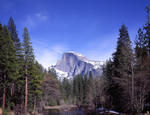
The Bridge Fire as viewed from Swamp Canyon on July 15th. NPS photo.
The Bridge Fire, the largest fire to ever burn at Bryce Canyon, presented some management challenges during its burn through the park, including the evacuation of 50 vehicles stranded in the southern portion of the park when a sudden change in conditions caused it to spread rapidly.
The fire was started by lightning on June 14th at Bridge Hollow on the Dixie National Forest, where it was closely monitored and managed for resource benefits, including re-establishing aspen and ponderosa pine and opening up the forest structure by reducing fuel loads. A month later, on July 14th, hot dry conditions and unpredictable winds from the southwest, gusting to 30 mph, carried the fire into the park. The flames spread quickly and winds carried spot fires across the main park road and below the rim.
By late afternoon, some 50 vehicles were stranded in the southern portion of the park. Since the main road ends at Rainbow Point to the south and the fire activity closed the road to the north, vehicles were evacuated from the park along the Yovimpa Pass Road by chief ranger Dave Fox. Another 10 vehicles (RV’s and motorcycles that could not travel on the dirt service road) were escorted along the main park road to the north when it was safe. Two miles in from the entrance station, the main park road was closed from July 14th to the 18th and reopened on the 19th. The Under-the-Rim Trail and most backcountry campsites were also closed. Occurring during peak summer season, the fire, along with closed roads, taxed the capacity of both the shuttle buses and limited parking spaces at the viewpoints.
On July 16th, a Type III interagency management organization was established for the incident. By July 21st, it was transitioned to back to a local management unit. Fire crews from Utah, Nevada and Arkansas were used on the fire. At the fire’s peak, the total number of firefighters and personnel (management, support, administration and fire) numbered 300. Four helicopters were used for aerial suppression actions on the fire. Fire crews established and secured fire lines, ignited burnout operations, handled spot fires and mopped up burned areas.
Both Bryce Canyon National Park and the Dixie National Forest Service teamed up to manage the fire with three different strategies – allowing fire for resource benefits on the western flank on USFS, full suppression at the southern tip on USFS, and full suppression with MIST (minimum impact suppression tactics) on the eastern flank within the park.
The park’s resources chief, Kelly Fuhrmann, and his staff provided resource advisor support on the fire, developed GIS fire maps, and met with fire crews to minimize impacts to peregrine falcon nesting sites adjoining the burned areas. Cooperative fire management strategies were also employed on USFS lands to protect goshawk nesting sites. Of the 1,856 acres burned within the park’s boundary, 701 were classified as a high severity burn. Water bars are being constructed on specific trails to minimize impacts from water runoff. Additional rehabilitation efforts include installing erosion barriers in steep drainages and reconstructing the boundary fence lost in the fire.
A total of 3,947 acres (about 50% in the park and 50% on USFS) have burned. The burned area stretches west on the Whiteman Bench and below the rim between Swamp Canyon and Farview Point. Along the west side of the park road, the visible burn stretches approximately 1.5 miles long between mile markers 8 and 10. Currently the Bridge Fire is 100% contained in the park and on the Dixie National Forest, continues to burn for resource benefits. Covering over 5% of the park’s area, this was the largest natural wildfire in Bryce Canyon’s history.
Today all roads, trails, facilities, campgrounds, viewpoints and visitor services are open. There were no injuries to the public or property damage during the fire. Minimal smoke and resulting hazy conditions will likely continue throughout the summer. Prescribed fires, such as the Puma Fire in 2008, are necessary to restore natural forest ecology, reduce fuel loads, enhance public safety and minimize the need for fire-related evacuations in the future.


